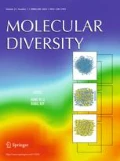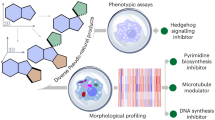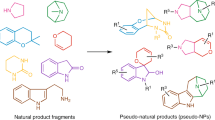Abstract
Macrocyclic natural products often display remarkable biological activities, and many of these compounds (or their derivatives) are used as drugs. The chemical diversity of these compounds is immense and may provide inspiration for innovative drug design. Therefore, a database of naturally occurring macrocycles was analyzed for ring size, molecular weight distribution, and the frequency of some common substructural motifs. The underlying principles of the chemical diversity are reviewed in terms of biosynthetic origin and nature’s strategies for diversity and complexity generation in relation to the structural diversity and similarities found in the macrocycle database. Finally, it is suggested that synthetic chemists should use not only nature’s molecules, but also nature’s strategies as a source of inspiration. To illustrate this, the biosynthesis of macrocycles by non-ribosomal peptide synthetases and terpene and polyketide cyclases, as well as recent advances of these strategies in an integrated synthesis/biotechnology approach are briefly reviewed.
Similar content being viewed by others
Abbreviations
- ACE:
-
angiotensin converting enzyme
- ACP:
-
acyl carrier protein
- AT:
-
acyl transferase
- C:
-
condensation
- 6-dEB:
-
6-deoxyerythronolide B
- DEBS:
-
deoxyerythronolide B synthase
- E:
-
epimerization (domain)
- GGPP:
-
geranylgeranyl diphosphate
- KR:
-
ketoreductase (domain)
- KS:
-
ketosynthase (domain)
- M:
-
N-methylation (domain)
- Nic:
-
nicotinoyl
- NRPS:
-
non-ribosomal peptide synthetase
- PCP:
-
peptidyl carrier protein
- PKS:
-
polyketide synthase
- QSAR:
-
quantitative structure-activity relationships
- TE:
-
thioesterase
References
Newman, D.J., Cragg, G.M. and Snader, K.M., Natural products as sources of new drugs over the period 1981–2002, J. Nat. Prod., 66 (2003) 1022–1037.
Rouhi, A.M., Rediscovering natural products, Chem. Eng., (2003) 77–107.
Wessjohann, L.A. and Ruijter, E., Total and diversity-oriented synthesis of natural product(-like) macrocycles, in Mulzer, J.H. (Ed.) Topics in Current Chemistry, Vol. 243: Springer, Heidelberg, 2004, pp. 137–184.
Henkel, T., Brunne, R.M., Mueller, H. and Reichel, F., Statistical investigation into the structural complementarity of natural products and synthetic compounds, Angew. Chem., 111 (1999) 688–691; Angew. Chem. Int. Ed., 38 (1999) 643–647.
Feher, M. and Schmidt, J.M., Property distributions: Differences between drugs, natural products, and molecules from combinatorial chemistry, J. Chem. Inf. Comput. Sci., 43 (2003) 218–227.
Link, A., Maßgeschneiderte Nadeln aus dem kombinatorischen Heuh-aufen, Pharmazeutische Zeitung, (2001) 3760–3766.
Lipinski, C.A., Lombardo, F., Dominy, B.W. and Feeney, P.J., Experimental and computational approaches to estimate solubility and permeability in drug discovery and development settings, Adv. Drug Delivery Rev., 46 (1997) 3–25.
Lee, M.-L. and Schneider, G., Scaffold architecture and pharmacophoric properties of natural products and trade drugs: Application in the design of natural product-based combinatorial libraries, J. Comb. Chem., 3 (2001) 284–289.
Nielsen, J., Combinatorial synthesis of natural products, Curr. Opin. Chem. Biol., 6 (2002) 297–305.
Wessjohann, L.A., Synthesis of natural product-based compound libraries, Curr. Opin. Chem. Biol., 4 (2000) 303–309.
Breinbauer, R., Manger, M., Scheck, M. and Waldmann, H., Natural product guided compound library development, Curr. Med. Chem., 9 (2002) 2129–2145.
Breinbauer, R., Vetter, I.R. and Waldmann, H., Von Proteindomänen zu Wirkstoffkandidaten–Naturstoffe als Leitstrukturen für das Design und die Synthese von Substanzbibliotheken, Angew. Chem., 114 (2002) 3002–3015; Angew. Chem. Int. Ed., 41 (2002) 2878–2890.
Stahl, P., Kissau, L., Mazitschek, R., Huwe, A., Furet, P., Giannis, A. and Waldmann, H., Total synthesis and biological evaluation of the nakajiquinones, J. Am. Chem. Soc., 123 (2001) 11586–11593.
Stahl, P., Kissau, L., Mazitschek, R., Giannis, A. and Waldmann, H., Naturstoffanaloga als Tyrosinkinaseinhibitoren: Identifikation von IGF1R-, Tie-2- und VEGFR-3-Inhibitoren, Angew. Chem., 114 (2002) 1222–1226; Angew. Chem. Int. Ed., 41 (2002) 1174–1178.
Lindsley, C.W., Chan, L.K., Goess, B.C., Joseph, R. and Shair, M.D., Solid-phase biomimetic synthesis of carpanone-like molecules, J. Am. Chem. Soc., 122 (2000) 422–423.
Corey, E.J. and Cheng, X.-M., The Logic of Chemical Synthesis, 1st edn., John Wiley & Sons, NewYork, 1989.
Nuhn, P., Naturstoffchemie, 3rd edn., S. Hirzel, Leipzig, 1997.
Nuhn, P. and Wessjohann, L.A., Naturstoffchemie – Mikrobielle, Pflanzliche und Tierische Naturstoffe, 4th edn., S. Hirzel, Stuttgart, 2005.
Dictionary of Natural Products on CD-ROM, Version 11:2, Chapman & Hall/CRC Press, 2003.
MDL Information Systems GmbH, http://www.beilstein.com/
Schmidt, H., Porzel, A., Wessjohann, L. and Vill, V., Phytobase – Trademark of the Leibniz-Institute of Plant Biochemistry, Halle (D), http://www.phytobase.de/.
SciDex—Volkmar Vill, LCI-Publisher GmbH, Hamburg (D), http://www.lci-publisher.com/..
Nicolaou, K.C., Boddy, C.N.C., Bräse, S. and Winssinger, N., Chemistry, biology, and medicine of the glycopeptide antibiotics, Angew. Chem., 111 (1999) 2230–2287; Angew. Chem. Int. Ed., 38 (1999) 2096–2152.
Bode, H.B., Bethe, B., Hofs, R. and Zeeck, A., Big effects from small changes: Possible ways to explore nature’s chemical diversity, ChemBioChem, 3 (2002) 619–627.
Galm, U., Dessoy, M.-A., Schmidt, J., Wessjohann, L.A. and Heide, L., In vitro and in vivo production of new aminocoumarins by a combined biochemical, genetic, and synthetic approach, Chem. Biol., 11 (2004) 173–183.
von Roepenack-Lahaye, E., Degenkolb, T., Zerjeski, M., Franz, M., Roth, U., Wessjohann, L., Schmidt, J., Scheel, D. and Clemens, S., Profiling of arabidopsis secondary metabolites by capillary liquid chromatography coupled to electrospray ionization quadrupole time-of-flight mass spectrometry, Plant Physiol., 134 (2004) 548–559.
Wessjohann, L.A., Brandt, W. and Thiemann, T., Biosynthesis and metabolism of cyclopropane-rings in natural compounds, Chem. Rev., 103 (2003) 1625–1647.
Gournelis, D.C., Laskaris, G.G. and Verpoorte, R., Cyclopeptide alkaloids, Nat. Prod. Rep., 14 (1997) 75–82.
Morel, A.F., Machado, E.C.S., Moreira, J.J., Menezes, A.S., Mostar deiro, M.A. and Wessjohann, L.A., Cyclopeptide alkaloids of Scutia buxifolia (Rhamnaceae), Phytochemistry, 47 (1998) 125–129.
Hardt, I.H., Steinmetz, H., Gerth, K., Sasse, F., Reichenbach, H. and Höfle, G., New natural epothilones from Sorangium cellulosum, strains So ce90/B2 and So ce90/D13: Isolation, structure elucidation, and SAR studies, J. Nat. Prod., 64 (2001) 847–856.
Wessjohann, L.A., Epothilones: Promising natural products with taxol-like activity, Angew. Chem., 109 (1997) 739–742; Angew. Chem. Int. Ed., (1997) 715–718.
Wessjohann, L.A., Scheid, G.O., Bornscheuer, U., Henke, E., Kuit, W. and Orru, R.V.A., Epothilone synthesis components III and IV: Asymmetrically substituted acyloins and acyloin derivatives, method for the production thereof and method for the production of epothilone B, D, and epothilone derivatives, In CAS 136:340534. 2002: Int. Patent Application WO2002/032844A2 (25.04.2002), EP 200111992 (16.10.2001).
Jin, Z., Muscarine, imidazol, oxazole and thiazole alkaloids, Nat. Prod. Rep., 20 (2003) 584–605.
Fürstner, A., Total syntheses and biological assessment of macrocyclic glycolipids, Eur. J. Org. Chem., (2004) 943–958.
Bigot, A., Bois-Choussy, M. and Zhu, J., An efficient total synthesis of K-13, a non-competitive inhibitor of ACE I, Tetrahedron Lett., 41 (2000) 4573–4578.
Marques, M.M.B., Pichlmair, S., Martin, H.J. and Mulzer, J., Stereocontrolled synthesis of C-arylglycosides applied to the south west fragment of the antibiotic kendomycin, Synthesis, (2002) 2766–2770.
Martin, H.J., Drescher, M., Kaehlig, H., Schneider, S. and Mulzer, J., Synthesis of the C1–C13 fragment of kendomycin: Atropisomerism around a C-aryl glycoside bond, Angew. Chem., 131 (2001) 3287–3289; Angew. Chem. Int. Ed., 40 (2001) 3186–3188.
Pichlmair, S., Marques, M.M.B., Green, M.P., Martin, H.J. and Mulzer, J., A novel approach toward the synthesis of kendomycin: Selective synthesis of a C-aryl glycoside as a single atropisomer, Org. Lett., 5 (2003) 4657–4659.
Bode, H.B. and Zeeck, A., Biosynthesis of kendomycin: Origin of the oxygen atoms and further investigations, J. Chem. Soc. Perkin Trans., 1 (2000) 2665–2670.
Bode, H.B. and Zeeck, A., Structure and biosynthesis of kendomycin, a carbocyclic ansa-compound from Streptomyces, J. Chem. Soc. Perkin Trans., 1 (2000) 323–328.
Kohli, R.M., Walsh, C.T. and Burkart, M.D., Biomimetic synthesis and optimization of cyclic peptide antibiotics, Nature, 418 (2002) 658–661.
Kingston, D.G.I., Taxol, a molecule for all seasons, Chem. Commun., (2001) 867–878.
Walker, F. and Croteau, R.B., The taxol biosynthetic genes, Phytochemistry, 58 (2001) 1–7.
Wessjohann, L.A., The first total syntheses of taxol, Angew. Chem., 106 (1994) 1011–1013; Angew. Chem. Int. Ed. Engl., 33 (1994) 959–961.
D’Souza, V.T. and Lipkowitz, K.B., Cyclodextrins: Introduction, Chem. Rev., 98 (1998) 1741–1742.
Saenger, W., Jacob, J., Gessler, K., Steiner, T., Hoffmann, D., Sanbe, H., Koizumi, K., Smith, S.M. and Takaha, T., Structures of the common cyclodextrins and their larger analogues-beyond the doughnut, Chem. Rev., 98 (1998) 1787–1802.
Szejtli, J., Introduction and general overview of cyclodextrin chemistry, Chem. Rev., 98 (1998) 1743–1754.
Uekama, K., Hirayama, F. and Irie, T., Cyclodextrin drug carrier systems, Chem. Rev., 98 (1998) 2045–2076.
Voigt, B., Schaks, A., Bögel, M., Brandt, W. and Wessjohann, L.A., Synthesis of steroid containing macrocycles via multi component reactions, In 2nd International Conference on Multi Component Reactions, Combinatorial and Related Chemistry (MCR 2003), 2003, Genua, Italy.
Katz, L., Manipulation of modular polyketide synthases, Chem. Rev., 97 (1997) 2557–2575.
Khosla, C., Harnessing the biosynthetic potential of modular polyketide synthases, Chem. Rev., 97 (1997) 2577–2590.
Staunton, J. and Wilkinson, B., Biosynthesis of erythromyin and rapamycin, Chem. Rev., 97 (1997) 2611–2629.
Gokhale, R.S., Hunziker, D., Cane, D.E. and Khosla, C., Mechanism and specificity of the terminal thioesterase domain from the erythromycin polyketide synthase, Chem. Biol., 6 (1999) 117–125.
Moffitt, M.C. and Neilan, B.A., The expansion of mechanistic and organismic diversity associated with non-ribosomal peptides, FEBS Microbiol. Lett., 191 (2000) 159–167.
Mootz, H.D. and Marahiel, M.A., Biosynthetic systems for nonribosomal peptide antibiotic assembly, Curr. Opin. Chem. Biol., 1 (1997) 543–551.
Schwarzer, D., Mootz, H.D. and Marahiel, M.A., Exploring the impact of different thioesterase domains for the design of hybrid peptide synthetases, Chem. Biol., 8 (2001) 997–1010.
Trauger, J.W., Kohli, R.M. and Walsh, C.T., Cyclization of backbone-substituted peptides catalyzed by the thioesterase domain from the tyrocidine nonribosomal peptide synthetase, Biochemistry, 40 (2001) 7092–7098.
Bordusa, F., Enzymes for peptide cyclization, ChemBioChem, 2 (2001) 405–409.
Tseng, C.C., Bruner, S.D., Kohli, R.M., Marahiel, M.A., Walsh, C.T. and Sieber, S.A., Characterization of the surfactin synthase C-terminal thioesterase domain as a cyclic depsipeptide synthase, Biochemistry, 41 (2002) 13350–13359.
Brandt, W., Dessoy, M.A., Fulhorst, M., Gao, W., Zenk, M.H. and Wessjohann, L.A., Structural basis for the reductive ring opening of the cyclodiphosphate MEcPP, a crucial transformation in the new DXP/MEP-pathway to isoprenoids, ChemBioChem, 5 (2004) 311–323.
Gao, W., Loeser, R., Raschke, M., Dessoy, M.A., Fulhorst, M., Alpermann, H., Wessjohann, L.A. and Zenk, M.H., (E)-4-Hydroxy-3-methylbut-2-enyl diphosphate: An intermediate in the formation of terpenoids in plant chromoplasts, Angew. Chem., 114 (2002) 2716–2719; Angew. Chem. Int. Ed., (2002) 2604–2607.
Bohlman, J., Meyer-Gauen, G. and Croteau, R.B., Plant terpenoid synthases: Molecular biology and phylogenetic analysis, Proc. Nat. Acad. Sci. U.S.A., 95 (1998) 4126–4133.
Trapp, S. and Croteau, R.B., Genomic organization of plant terpene synthases and molecular evolutionary implications, Genetics, 158 (2001) 811–832.
Dewick, P.M., The biosynthesis of C5–C25 terpenoids compounds, Nat. Prod. Rep., 16 (1999) 97–130.
Dewick, P.M., The biosynthesis of C5–C25 terpenoids compounds, Nat. Prod. Rep., 19 (2002) 181–222.
Pyun, H.-J., Wagschal, K.C., Jung, D.-I., Coates, R.M. and Croteau, R., Monoterpene biosynthesis: Isotope effects associated with bicyclic olefin formation catalyzed by pinene synthases from sage (Salvia officinalis), Arch. Biochem. Biophys., (1994) 488–496.
Caruthers, J.M., Kang, I., Rynkiewicz, M.J., Cane, D.E. and Christianson, D.W., Crystal structure determination of aristolochene synthase from the blue cheese mold, Penicillium roqueforti, J. Biol. Chem., 275 (2000) 25533–25539.
Rynkiewicz, M.J., Cane, D.E. and Christianson, D.W., From the cover: Structure of trichodiene synthase from Fusarium sporotrichioides provides mechanistic inferences on the terpene cyclization cascade, Proc. Nat. Acad. Sci. U.S.A., 98 (2001) 13543–13548.
Bräuer, L., Brandt, W. and Wessjohann, L.A., Modeling of the E. coli 4-hydroxybenzoic acid oligoprenyl transferase (ubiA-transferase) and characterization of potential active sites, J. Mol. Mod., 10 (2004) 317–327.
Starks, C.M., Back, K., Chappel, J. and Noel, J.P., Structural basis for cyclic terpene biosynthesis by tobacco 5-epi-aristolochene synthase, Science, 277 (1997) 1815–1820.
Conolly, J.D. and Hill, R.A., Dictionary of Terpenoids, Chapman & Hall, New York, 1992.
Whittington, D.A., Wise, M.L., Urbansky, M., Coates, R.M., Croteau, R.B. and Christianson, D.W., Biochemistry, 24 (2002) 15375–15380.
Brown, G.D., The biosynthesis of steroids and triterpenoids, Nat. Prod. Rep., 16 (1998) 653–696.
MacMillan, J. and Beale, M.H., Comprehensive Natural Products Chemistry, Elsevier Science Publishing Co., Inc., New York, 1999.
Ait-Ali, T., Swain, S.M., Reid, J.B., Sun, T.P. and Kamiya, Y., The LS locus of pea encodes the gibberellin biosynthesis enzyme ent-kaurene synthase A, Plant J., 11 (1997) 443–454.
Hedden, P. and Kamiya, Y., Gibbelerin biosynthesis: Enzymes, genes and their regulation, Ann. Rev. Plant Physiol. Plant Mol. Biol., 48 (1997) 431–460.
Wendt, K.U., Poralra, K. and Schulz, E., Structure and function of a squalene cyclase, Science, 277 (1997) 1811–1815.
Wendt, K.U., Lenhart, A. and Schulz, E., The structure of the membrane protein squalene-hopene cyclase at 2.0 A resolution, J. Mol. Biol., 286 (1999) 175–187.
Wendt, K.U., Schulz, E., Corey, E.J. and Liu, D.R., Enzyme mechanisms for polycyclic triterpene formation, Angew. Chem., 112 (2000) 2930–2952; Angew. Chem. Int. Ed., 39 (2000) 2812–2833.
Wessjohann, L.A. and Sontag, B., Prenylation of benzoic acid derivatives catalyzed by a transferase from Escherichia coli overproduction: Method development and substrate specificity, Angew. Chem., 108 (1996) 1821–1823; Angew. Chem. Int. Ed. Engl., (1996) 1697–1699.
Wessjohann, L.A., Sontag, B. and Dessoy, M.-A., Enzymatic C–C coupling: The development of aromatic prenylation for organic synthesis, In Diederichsen, U., Lindhorst, T.L., Wessjohann, L.A. and Westermann, B. (Eds.) Bioorganic Chemistry – Highlights and New Aspects, Wiley-VCH, Weinheim, 1999, pp. 79–88.
Huang, K., Huang, Q. and Scott, A.I., Overexpression, single-step purification, and site-directed mutagenetic analysis of casbene synthase, Arch. Biochem. Biophys., 352 (1998) 144–152.
Hill, A.M., Cane, D.E., Mau, C.J. and West, C.A., High level expression of Ricinus communis casbene synthase in Escherichia coli and characterization of the recombinant enzyme, Arch. Biochem. Biophys., 336 (1996) 283–289.
Wildung, M. and Croteau, R.B., A cDNA clone for taxadiene synthase, the diterpene cyclase that catalyzes the committed step of taxol biosynthesis, J. Biol. Chem., 271 (1996) 9201–9204.
Hamano, Y., Kuzumaya, T., Itoh, N., Furihata, K., Seto, H. and Dairi, T., Functional analysis of eubacterial diterpene cyclases responsible for biosynthesis of a diterpene antibiotic, terpentecin, J. Biol. Chem., 277 (2002) 37098–37104.
Hanson, J.R., Diterpenoids, Nat. Prod. Rep., 19 (2002) 125–132.
Hanson, J.R., Diterpenoids, Nat. Prod. Rep., 17 (2000) 165–174.
Hanson, J.R., Diterpenoids, Nat. Prod. Rep., 20 (2003) 70–78.
Lambert, J.N., Mitchell, J.P. and Roberts, K.D., The synthesis of cyclic peptides, J. Chem. Soc. Perkin Trans. 1, (2001) 471–484.
van Maarseveen, J.H., den Hartog, J.A.J., Engelen, V., Finner, E., Visser, G. and Kruse, C.G., Solid phase ring-closing metathesis: Cyclization/cleavage approach towards a seven membered cycloolefin, Tetrahedron Lett., 37 (1996) 8249–8252.
van Maarseveen, J.H., Solid phase synthesis of heterocycles by cyclization/cleavage methodologies, Comb. Chem. High Thr. Scr., 1 (1998) 185–214.
Park, K.-H. and Kurth, M.J., Cyclo-elimination release strategies applied to solid-phase organic synthesis in drug discovery, Drugs Fut., 25 (2000) 1265–1294.
Akritopoulou-Zanze, I. and Sowin, T.J., Solid-phase synthesis of macrolide analogues, J. Comb. Chem., 3 (2001) 301–311.
Cristau, P., Vors, J.-P. and Zhu, J., Solid-phase synthesis of natural product-like macrocycles by a sequence of Ugi-4CR andNAr-based cycloetherification, Tetrahedron Lett., 44 (2003) 5575–5578.
Brohm, D., Philipe, N., Metzger, S., Bhargava, A., Müller, O., Lieb, F. and Waldmann, H., Solid-phase synthesis of dysidiolide-derived protein phosphatase inhibitors, J. Am. Chem. Soc., 124 (2002) 13171–13178.
Sieber, S.A., Tao, J., Walsh, C.T. and Marahiel, M.A., Peptidyl thiophenols as substrates for nonribosomal peptide cyclases, Angew. Chem., 116 (2004) 499–504; Angew. Chem. Int. Ed., 43 (2004) 493–498.
Ulijn, R.V., Baragana, B., Halling, P.J. and Flitsch, S.L., Protease-catalyzed peptide synthesis on solid support, J. Am. Chem. Soc., 124 (2002) 10988–10989.
Basso, A., De Martin, L., Gardossi, L., Margetts, G., Brazendale, I., Bosma, A.Y., Ulijn, R.V. and Flitsch, S.L., Improved biotransformations on charged PEGA supports, Chem. Commun., (2003) 1296–1297.
Zhu, M., Ruijter, E. and Wessjohann, L.A., A new scavenger resin for the reversible linking and monoprotection of functionalized aromatic aldehydes, Org. Lett., 6 (2004) 3921–3924.
Makita, A., Nihira, T. and Yamada, Y., Lipase catalyzed synthesis of macrocyclic lactones in organic solvents, Tetrahedron Lett., 28 (1987) 805–808.
Antczak, U., Gora, J., Antczak, T. and Galas, E., Enzymatic lactonization of 15-dihydroxypentadecanoic acid and 16-hydroxyhexadecanoic acids to macrocyclic lactones, Enzyme Microb. Technol., 13 (1991) 589–593.
Mori, K. and Tomioka, H., Synthesis of four macrolide pheromones to define the scope and limitation of enzymatic macrolactonization, Liebigs Ann., (1992) 1011–1018.
Lu, W. and Sih, C.J., Chemoenzymatic synthesis of macrocyclic polyamines, Tetrahedron Lett., 40 (1999) 4965–4968.
Author information
Authors and Affiliations
Corresponding author
Rights and permissions
About this article
Cite this article
Wessjohann, L.A., Ruijter, E., Garcia-Rivera, D. et al. What can a chemist learn from nature’s macrocycles? – A brief, conceptual view. Mol Divers 9, 171–186 (2005). https://doi.org/10.1007/s11030-005-1314-x
Received:
Accepted:
Issue Date:
DOI: https://doi.org/10.1007/s11030-005-1314-x




